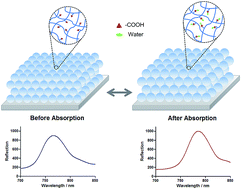Self-assembly of a nano hydrogel colloidal array for the sensing of humidity
Abstract
Traditional artificial opals are assembled from silica or polystylene colloidals which have poor swellability and a lower response to stimuli. A novel three-dimensional photonic crystal array sensor which has a high stability and desired structural colour was fabricated from the self assembly of nano hydrogel colloids. The nano hydrogel colloids were prepared by co-polymerisation of N-isopropylacrylamide, functional monomer acrylic acid and N-tert-butylacrylamide. The relative humidity from 20% to 100% could be detected rapidly via the reflection spectrum of the nano hydrogel colloidal array with a maximum amount of red shift of 24 nm. The response kinetics for humidity of the nano hydrogel colloidal array were investigated, and correspondingly, a rational response mechanism of the compactness of the close-packed structure caused by the swelling of the nano hydrogel colloidal array was discussed. The nano hydrogel colloidal array sensor presented good reversibility and can be reused for at least five rounds.



 Please wait while we load your content...
Please wait while we load your content...